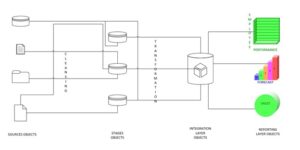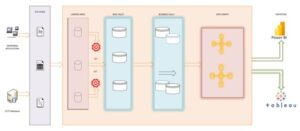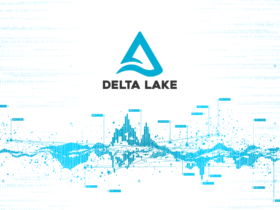
Content:
- Approaches to modelling
- Hubs, Link and Satellite
Approaches to Modelling
Traditional Approaches:
The successful growth of any business depends on the choice of the right competitive advantage and this will help sustainability. As a part of the competitive advantage business methodologies employ the use of technology and its precedence to a greater extent in today’s digital realm. Here choosing the right tools is a very integral part and its selection is crucial.
The choice of tools and adopting the right methodologies becomes the drive for any business and in this the selection on the database technologies is very crucial. Here the practice of data warehousing and warehouse system is very important and the use of right modelling techniques has become a very important factor in todays’ competitive world.
In this choice, Big Data will play an important role and its choice is also inevitably crucial in the Business Intelligence and related systems. The use of traditional 3 NF of Bill Inmon in the relational model and Ralf Kimball’s Star Schema design for the OLAP would be a bit outdated. So, here the argument on what to use and where to use become an important topic to be considered and here we can rather focus on some of the adaptable and sensitive models and we begin to consider the data vaults’ technique.
The enterprise data warehouse systems must be able to provide valuable and relevant information to business processes and downstream applications including user queries and reporting requirements. To do this the data driven approach that today’s company’s employ must be more adaptable and susceptible to change because if the EDW/BI systems fails to provide this, how will the change in information be addressed.?
Capturing the data and in today’s system the process of data capturing, data profiling, data cleansing and data transformation will be a huge picture as the data is just not data but Big data and this will be following all the characteristics of the big data paradigm.
Moreover, in today’s modelling and data driven approaches for systems has a lot of sub-lying concepts and techniques to be addressed and approached as per he required standards and in lieu of the same the need for addressing the administration, design, development, maintenance and support using various different and here we get into the complexity of the design.
The business needs are very dynamic and to address the same the enterprise warehouse needs to highly flexible in nature and to get the same fixed for each business domain and their answers the enterprise needs to be highly dependent on a system that is purely a mix of all the requirements and be in a position to answer them all. Kimball’s dimensional modelling or the star schema and Inmon’s normalized or snowflake needs to be overseen in a very high perspective to address the above all and for this we get into an approach of OLAP cubes where the data is viewed in different cubical perspectives. But this approach would also be more susceptible to cost and build factors.

Traditional Architecture
Data Vault Approach:
Data Vaults are nothing but a type of hybrid and new breed of approach to the modelling techniques which is more resilient and susceptible to changes. This resilient data base is capable of providing a platform to represent and save historical data for a captive analytical purpose. It has a wide capacity to collaborate 3NF and star schemas to minimize the change pattern, big, rather huge volumes, strange complexities and integrate drawback and bring out strong business model analysis efficiently.
Normally traditional warehouses found it very hard to implements an agile system of approach in building a traditional data/enterprise warehouse for their business needs. With the scale up of data vault approach, we could in simpler terms define or affirmative a data vault as an enterprise approach which is more agile in handling the changing data needs and build a data warehousing, analytics and data science requirements that need to run agile data warehouse projects where scalability, integration, development speed and business orientation are important.
So, what is a data vault model or modelling approach?
So, a data vault model forms the core for a data vault approach and is a data modeling design pattern used to build a data warehouse for organizations adopting enterprise-scalable analytics as and for its solutions. This type of architecture is more preferred in any enterprise where agile is more predominant and also suits any data lake paradigms.
This methodology has mainly three main core units or base components in its enterprise architecture and they are being the HUB, LINK and the SATELLITE where the hubs represent the core of the business, the links represent the relationships between the hubs and the satellite represents the information about the hubs and relationships between them. Based on how these constructs are interconnected and related the model approach is categorized as standard; where each component is always constructed the same way to each other, simple; an easy to understand methodology which will be easy to deploy with a bit of familiarity and connected; where hubs will connect to links and satellites, links connect to hubs and satellites, and satellites connect to hubs or links dedicatedly.

Data Vault Architecture
Benefits of Data Vault Technique:
As it is very clearly inferred from the above conceptual architecture a data vault technique is more scalable till and above Peta bytes of data, being ready for refactoring, more agile, can use familiar architecture principles using most available ETL/ELT codes and they can be generated at will. Auditability and traceability become more easier here facilitating business key usages and can accommodate almost a variety of data formats and standards also keeping in mind to make it easy for data profiling and cleansing methods. System loads and bottlenecks can be handled and attended more easier that before.
Though there are a lot of benefits for a data vault implementation to be deployed in an enterprise business, there are few drawback as well notably being, if data is to be loaded into a reporting system directly it becomes a question to ask as due to the interconnection and joins it may slow down the system to a considerable extent and in a situation where there is a single source it is again a complex architecture which can be more effectively be achieved using a traditional system rather…







